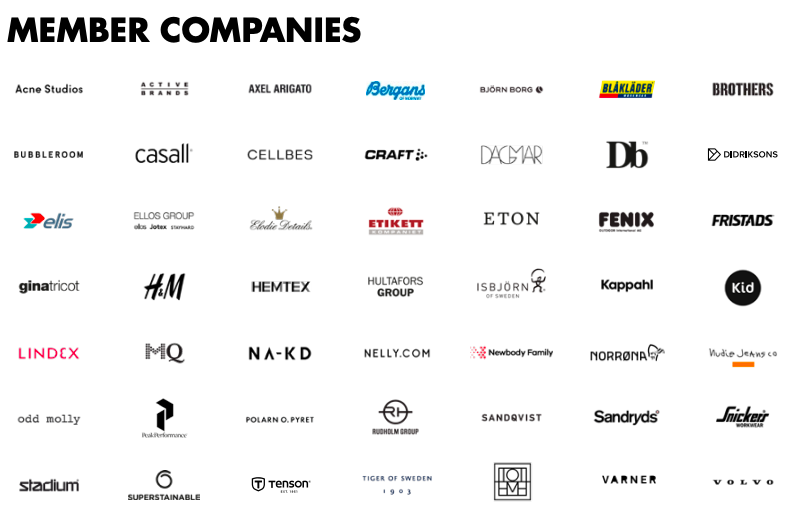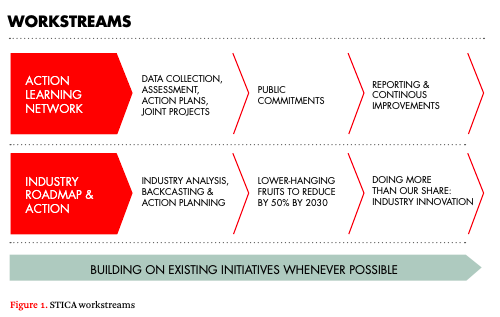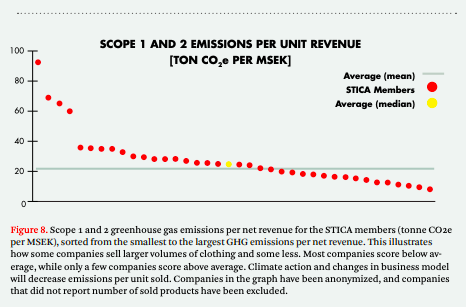Are the Swedish fashion brands in line with reducing their emissions according to the Paris Agreement?
To answer this question you can read the Progress Report 2022 launched by The Swedish Textile Initiative for Climate Action (STICA) that came out 26 April. STICA is an initiative launched by the non-governmental organisation Sustainable Fashion Academy together with apparel and textile brands and companies. Important stakeholders are also involved and the aim of STICA is to reduce their climate impact in line with the 1.5 global average Celsius degree target. The initiative works in two ways: one is The Action Learning Network which supports brands to reduce their emissions and transform their businesses. Brands comes from a variety of segments such as outdoor, workwear, laundry, accessories and fashion. The other is the Industry Level Action which works with key stakeholders to develop a roadmap for the whole Swedish apparel and textile industry to reduce their emissions and enable global industrial change.
Several well-known fashion brands from Sweden and the nordic region are members such as Acne Studios, Lindex, Casall, H&M, Lindex, Gina Tricot, Kappahl and Björn Borg. 41 brands in total are included.
These brands can cut their emissions in several ways by using materials more efficiently, to source more sustainable materials, invest in development and innovation for more climate friendly materials, source materials from energy efficient factories, eliminating fossil fuels in the energy source supply chain and source from factories that are using renewable energy.
The brands needs to set targets, measure and report to STICA in line with the Science Based Target Initiative and the GHG Protocol. Here are the requirements:
Public targets for Scopes 1, 2 and 3 (scope 1 being direct emissions, scope 2 from purchased energy and scope 3 from the value chain).
Targets in line with what it will take to limit warming to no more than 1.5 C, which in practice means reducing absolute emissions by roughly half by 2030.
If a member company cannot commit to the targets and reductions required to stay on a 1.5 C pathway, the company can select a temporary target, explain why, and present a plan for what is needed to be able to do so. These exceptions are addressed on a case-by-case basis.
What are the results for 2022?
In the report you can read the yearly revenue of the company, their total emissions (including scope 1 and scope 2), their yearly reduction, their reduction targets and the reduction needed to reach their targets. Some brands are lacking data or targets such as, Tenson and Elis. Some brands are not measuring scope 3 yet, which is essential since that include the emission form textile production. Majority of clothes emissions are happening in the production phase. Some of the brands not measuring their scope 3 emissions are: Bubbleroom, Newbody and Craft. Since most brands have just recently started to measure their scope 3, the majority do not have data on the yearly reduction. To measure scope 3 is not easy, but it is misleading for consumers if data and reporting is only done on scope 1 and 2. With energy reduction in offices and stores, it can look like the brand is taking big responsibilities while data from the clothes and textiles per see are not included. Some of the brands that do measure scope 3 and have reduction data are Kappahl, Lindex, Nudie Jeans and Stadium. H&M is excluded from the graphic since they represent 91% of the total emissions from the STICA members. This is a big indicator of how important H&M work and commitments are to reduce their emissions and be a role model and key player for fashion brands sustainability work. H&M excluded, 95% of the members emissions comes from the production phase. The total emissions from the STICA members are (excluding H&M) 1 661 629 tons CO2e and from other members 12 911 948 tons CO2e. If you calculate per unit it is 7.5-10 kg CO2e that is being emitted with big variations depending on brand and product category.
Of the 33 brands that have been reporting regularly, 18 have reduced their annual emissions according to their target and four have already fulfilled their targets. 13 brands are not reducing their emissions as fast as required.
What can we learn from the report?
Several fashion brands have started late with proper climate reporting and work that is now being done should have been done years ago. However, it is better to be late than never to start. Further, brands have set targets and some are reducing their emissions but the data is shown in total figures which is essential to have a real effect on the climate, the climate does not care about emissions per unit, if total emissions goes up globally it doesn’t really matter, but to be able to know the effects of the pandemic and the potential expansion or reduction of apparel and textile brands businesses, measures per unit is essential too. As a reader I would like to know to what extent the reduced emissions might be related to reduce sales. Because if we want to change the fashion industry, they need to reduce emissions but still have sustainable businesses. A de-coupling (reducing emissions why keep doing business as usual) might work in the beginning for some brands. You can always change materials, cut waste, switch energy source, but in the long run it will come down to the volume of products you’re producing. Brands growth ambitions and the potential to be in conflict with emissions reductions are called The Elephant in the room, and you can read more about it on page 33 in the report.
It can’t be emphasised enough how important the sustainability work done by H&M is. Last year they decreased their emissions by 2% but in order to stay in line with their reduction target of 56% in absolute emissions by 2030 from a 2019 base year, the yearly reduction needs to be 5.4%. They are by far the largest emitter and therefore their yearly reduction needs to decrease faster.
Further, there are a few good examples of brands that are reducing their emissions including scope 3 and in line with their targets, such as Lindex, Stadium and Kappahl, but in what ways is this related to decreased consumption due to the pandemic? An answer to this can be given beyond the report where Lindex for example had their largest sale ever in 2021. Some brands might have been able to decrease emissions while keeping sales up, but as mentioned before, sooner or later the low hanging fruits are all taken and the resources used for new production can only be cut from using already produced fabrics.
This does not mean we are negative. The report and the method used are according to global standard and best practice. Transparency is key in any industrial transformation. We agree with the authors that brands initiatives are not enough, legislation and law enforcement is essential for faster reduction. The brands who have started their journey should be encouraged and empowered to do so, but as sustainability professionals it is our role to say what the climate crisis needs to hear.
It is not enough and the big players needs to do more.






